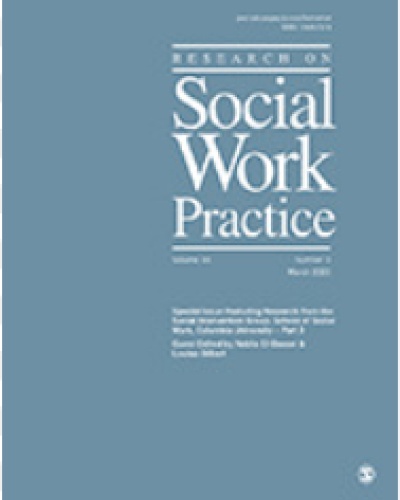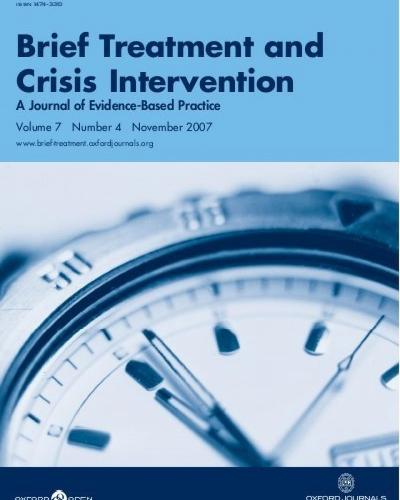
The Relationship between Lifetime Opioid Use and Mental and Physical Health among Incarcerated Individuals
Published:
| Author: Tanya Renn, John Moore, Christopher Veeh, Carrie Pettus
Relationships between opioid use and health, both physical and mental, have been discovered over the last decade or so, but these relationships have yet to be explored among incarcerated individuals. These relationships are important as they may have implications on the health of those who are incarcerated and nearing reentry, because higher rates of opioid use, as well as poor physical and mental health, are found among those who are justice-involved compared with the general population.
Category: Substance Use, Mental Health, Incarceration

Behavioral Health Interventions for Incarcerated Adults With Histories of Trauma: A Scoping Review
Published:
| Author: Melissa D. Grady, Stephen Tripodi, Lauren Herod, Michael Rudzinski
The majority of incarcerated individuals have experienced traumatic events in their lifetime, contributing to related behavioral health issues, including post-traumatic stress, mood, anxiety, and substance use disorders. The purpose of this article is to understand the existing state of the literature through a scoping review on correctional-based programs that address both trauma and behavioral health.
Category: Trauma, Mental Health, Substance Use

Behavioral health literacy: A new construct to improve outcomes among incarcerated individuals
Published:
| Author: Carrie Pettus, Stephanie Kennedy, Tanya Renn, Stephen Tripodi, Lauren Herod, Danielle Rudes, Faye Taxman
In the United States, nearly 13 million adults are incarcerated in prisons and jails annually with significant negative public health consequences. Incarcerated individuals have disproportionate rates of behavioral health disorders (BHDs); untreated BHD symptoms bring people into incarceration settings and are associated with re-arrest after release.
Category: Incarceration, Mental Health, Reentry, Substance Use

Traumatic Brain Injury and Health-Related Quality of Life: A Cross-Sectional Study of Incarcerated Adults
Published:
| Author: Christopher Veeh, Tanya Renn, John Moore
Informed by the health-based model of desistance, the current study undertook a preliminary investigation into whether TBI impacted levels of HRQoL in incarcerated adults who are preparing to be released from prison. The following research question guided the study: Do incarcerated adults with a lifetime history of TBI report lower HRQoL compared with incarcerated individuals without a TBI history? We hypothesized that TBI would have a negative association with an individual’s HRQoL.
Category: Incarceration, Mental Health

The Relationship Between Severe Mental Disorders and Recidivism in a Sample of Women Released from Prison.
Published:
| Author: Erin A. King, Stephen Tripodi, Christopher Veeh
Women are one of the fastest growing sectors of the prison population, and have different pathways into prison and differing needs during the reentry process when compared to men. Women report higher levels of mental health problems overall, and report more severe symptomatology. The current study focuses on the role of severe mental disorders (SMDs) for 2,311 women released from prison and how SMDs relate to recidivism. Women diagnosed with SMDs were 16% more likely to have recidivated at eight years post-release compared with women who were not diagnosed with an SMD (p < .05).
Category: Reentry, Recidivism, Mental Health, Incarcerated Women
Examining Dose–Response Relationships Between Childhood Victimization, Depression, Symptoms of Psychosis, and Substance Misuse for Incarcerated Women
Published:
| Author: Stephanie Kennedy, Stephen Tripodi, Carrie Pettus-Davis, Jaime Ayers
The current study uses the dose–response model to examine the relationships between childhood victimization events and subsequent depression, symptoms of psychosis, and substance misuse in a sample of 230 randomly selected incarcerated women in the United States. Results on the frequency of victimization were mixed. In this sample, both frequency of physical abuse and frequency of sexual abuse significantly predicted current symptoms of psychosis, but only frequency of physical abuse significantly predicted substance misuse.
Category: Trauma, Mental Health, Substance Use

The relationship between childhood abuse and psychosis for women prisoners: Assessing the importance of frequency and type of victimization.
Published:
| Author: Stephanie Kennedy, Stephen Tripodi, Carrie Pettus-Davis
This study examines the relationship between childhood victimization and self-reported current symptoms of psychosis in an incarcerated female population in the United States. Participants are 159 randomly selected women incarcerated in two North Carolina state prisons. Participants completed a battery of self-report measures to assess childhood victimization and current and lifetime experience of audio/visual hallucinations and delusions.
Category: Trauma, Mental Health, Incarcerated Women

Nonfatal Suicidal Behavior Among Women Prisoners: The Predictive Roles of Childhood Victimization, Childhood Neglect, and Childhood Positive Support
Published:
| Author: Stephen Tripodi, Eyitayo Onifade, Carrie Pettus-Davis
Women entering prison report high rates of childhood victimization. Women in prison also report higher rates of nonfatal suicidal behavior (self-reported suicide attempts) than women in the general population and similar rates to their male counterparts despite having significantly lower suicide rates than males in the general population. Yet, there is a dearth of research that addresses the relationship between childhood victimization and suicidality for women prisoners in the United States.
Category: Trauma, Social Support, Mental Health, Incarcerated Women

Effects of personality disorder and impulsivity on emotional adaptations in prison among women offenders.
Published:
| Author: Senik Mahmood, Stephen Tripodi, Michael Vaughn, Kimberly Bender, Rachel Schwartz
The present study sought to better understand the influence of personality disorders and impulsivity on women's ability to adapt to incarceration. We analyzed the influence of personality disorders as screened with the structured clinical interview for personality disorders, and impulsivity as assessed with the Barratt impulsivity scale on depression and anxiety, sleeping problems, and feeling afraid of being attacked in prison among a large sample of women incarcerated in a Virginia prison.
Category: Mental Health, Incarcerated Women

Histories of childhood victimization and subsequent mental health problems, substance use, and sexual victimization for a sample of incarcerated women in the US.
Published:
| Author: Stephen Tripodi, Carrie Pettus-Davis
Women are entering US prisons at nearly double the rate of men and are the fastest growing prison population. Current extant literature focuses on the prevalence of the incarceration of women, but few studies exist that emphasize the different trajectories to prison. For example, women prisoners have greater experiences of prior victimization, more reports of mental illness, and higher rates of illicit substance use.
Category: Incarcerated Women, Trauma, Mental Health, Substance Use

Inmate suicide: Prevalence, assessment and protocols.
Published:
| Author: Stephen Tripodi, Kimberly Bender
This article describes the prevalence of suicide for incarcerated adults in detention centers, jails, and prisons; factors associated with suicide risk; methods for assessing suicide risk in this vulnerable population; and current protocols for suicide prevention programs in jails and prisons.

